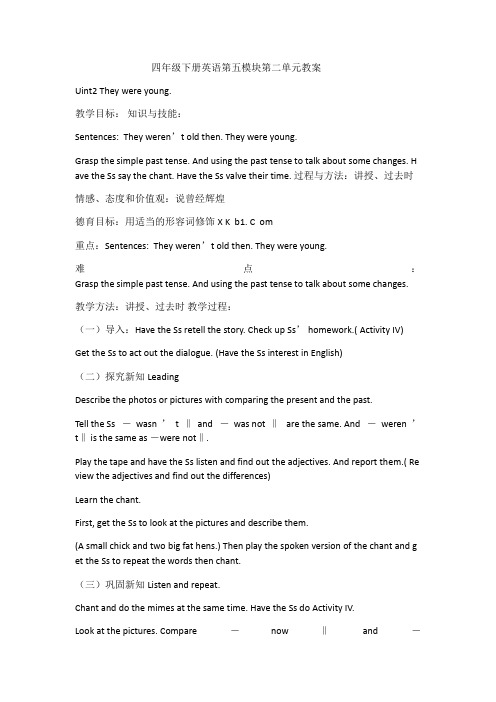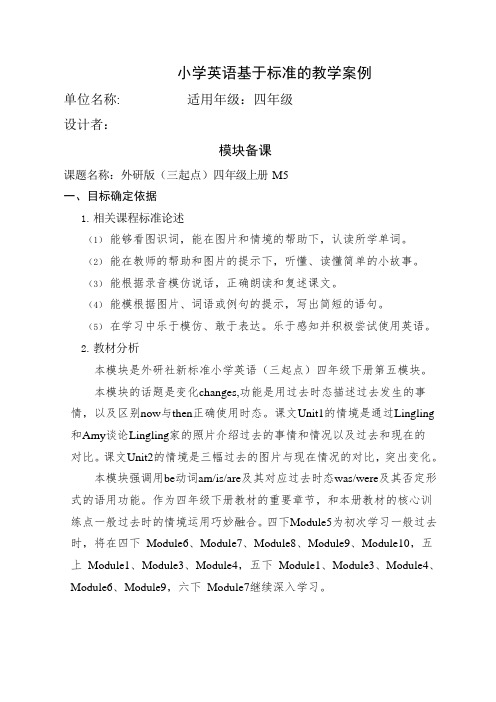四年级英语下册第五模块教案
- 格式:doc
- 大小:33.00 KB
- 文档页数:2

四年级下册英语第五模块第二单元教案Uint2 They were young.教学目标:知识与技能:Sentences: They weren’t old then. They were young.Grasp the simple past tense. And using the past tense to talk about some changes. H ave the Ss say the chant. Have the Ss valve their time. 过程与方法:讲授、过去时情感、态度和价值观:说曾经辉煌德育目标:用适当的形容词修饰X K b1. C om重点:Sentences: They weren’t old then. They were young.难点:Grasp the simple past tense. And using the past tense to talk about some changes.教学方法:讲授、过去时教学过程:(一)导入:Have the Ss retell the story. Check up Ss’ homework.( Activity IV)Get the Ss to act out the dialogue. (Have the Ss interest in English)(二)探究新知LeadingDescribe the photos or pictures with comparing the present and the past.Tell the Ss ―wasn’t‖and ―was not‖ are the same. And ―weren’t‖ is the same as ―were not‖.Play the tape and have the Ss listen and find out the adjectives. And report them.( Re view the adjectives and find out the differences)Learn the chant.First, get the Ss to look at the pictures and describe them.(A small chick and two big fat hens.) Then play the spoken version of the chant and g et the Ss to repeat the words then chant.(三)巩固新知Listen and repeat.Chant and do the mimes at the same time. Have the Ss do Activity IV.Look at the pictures. Compare ―now‖ and ―then‖. Then describe the pictures. (Cultivate the Ss’ oral English.)4. Do the Activity Book. Have the Ss work in groups. Sa will act out Sb who was in ma ny years ago. Then Sc will introduce the two Ss. Find out some changes with the past and present tense.(四)作业布置(五)小结:接触一般过去时板书设计Unit2 They were young.They weren’t old then. weren't →were notThey were young. wasn't → was notA: Was it fat?B: No, it wasn’t. It’s thin.课后反思:。

小学英语基于标准的教学案例单位名称: 适用年级:四年级设计者:模块备课课题名称:外研版(三起点)四年级上册M5一、目标确定依据1.相关课程标准论述(1)能够看图识词,能在图片和情境的帮助下,认读所学单词。
(2)能在教师的帮助和图片的提示下,听懂、读懂简单的小故事。
(3)能根据录音模仿说话,正确朗读和复述课文。
(4)能模根据图片、词语或例句的提示,写出简短的语句。
(5)在学习中乐于模仿、敢于表达。
乐于感知并积极尝试使用英语。
2.教材分析本模块是外研社新标准小学英语(三起点)四年级下册第五模块。
本模块的话题是变化changes,功能是用过去时态描述过去发生的事情,以及区别now与then正确使用时态。
课文Unit1的情境是通过Lingling 和Amy谈论Lingling家的照片介绍过去的事情和情况以及过去和现在的对比。
课文Unit2的情境是三幅过去的图片与现在情况的对比,突出变化。
本模块强调用be动词am/is/are及其对应过去时态was/were及其否定形式的语用功能。
作为四年级下册教材的重要章节,和本册教材的核心训练点一般过去时的情境运用巧妙融合。
四下Module5为初次学习一般过去时,将在四下Module6、Module7、Module8、Module9、Module10,五上Module1、Module3、Module4,五下Module1、Module3、Module4、Module6、Module9,六下Module7继续深入学习。
3.学情分析(1)生理、心理特点:四年级学生经过一年半的学习,已有一定的英语基础,且仍对英语保持着相当大的兴趣和积极性,但本年龄段的孩子注意力不稳定,容易被刺激的事物所吸引,所以课堂可多运用游戏的方式寓教于乐。
(2)认知基础:四年级学生已积累了一定的学习方法,并具备初步的英语听、说、读、写能力,能基本了解并运用相关语法知识。
(3)生活经验:四年级学生已经具备较强的观察和表述能力,乐于发现和表达。

部编版四年级英语下册第五单元教案(含整个单元)第一课时- 教学目标:通过研究本课时内容,学生能够掌握以下知识点:- 研究并能正确使用单词:tiger, panda, zebra, kangaroo, lion;- 能够使用句型 "What's this? It's a/an..." 进行简单的单词描述;- 能够听懂、理解并能正确回答基本问题。
- 教学准备:- 教学课件;- 卡片:tiger, panda, zebra, kangaroo, lion;- 一些图书和图片。
- 教学步骤:1. 导入新课,通过展示图片激发学生研究兴趣,引导学生猜测图片中的动物。
2. 向学生出示卡片,并鼓励他们说出卡片上的单词。
3. 引导学生用英语问问题:"What's this?" 并回答:"It's a/an..."。
4. 教师出示多个动物图片,让学生通过问与答的方式进行描述。
5. 听音乐。
老师播放 "What's this?" 音频,学生边听边看图片判断正确答案。
6. 学生小组活动,每组选择一本图书,用英语交流描述书中的动物。
7. 教师进行总结,鼓励学生积极参与。
- 教学扩展:- 让学生进行角色扮演,模拟对话描述动物;- 制作学生自制的英语动物相册;- 让学生画出自己最喜欢的动物,并以英语进行介绍。
第二课时- 教学目标:通过研究本课时内容,学生能够掌握以下知识点:- 研究并能正确使用单词:dog, cat, rabbit, bird, fish;- 能够运用 "What's this? It's a/an..." 句型进行简单的单词介绍;- 能够听懂、理解并能正确回答相关问题。
- 教学准备:- 教学课件;- 卡片:dog, cat, rabbit, bird, fish;- 一些玩具动物。

单元教材及学情分析i. 单元教材分析本单元主要通过学习服装类名词来进一步学习特殊疑问句和物主代词,同时,进一步学习一般疑问句和名词所有格的运用,从而培养学生日常口语的交际能力。
学会用特殊疑问词whose 和名词性物主代词以及名词所有格,另外,要求学生能根据简单的祈使句做相应的动作。
涉及的主要句型有:lt' time to go home.Amy, are these yours?No, they aren 'My shoes are gree n. They are Chen Jie '.Are theseyours,Mike?Yes,theyare.Whose coat is this?It ' mine.Whose pants are those?They re your father '.教师在教学过程中要注意whose和物主代词的应用,这也是本单元的重点。
同时,要培养学生良好的生活习惯,培养学生热爱劳动的好习惯。
涉及这方面的内容时,要结合我们的日常生活适当拓展。
本单元涉及了很多名词复数形式,因此, 我们要把新旧知识融合在一起,学习新知识的同时也要巩固以前的知识,让学生对知识有系统的了解。
本单元的教学重点是物主代词和服装类名词:mine, hers, his, yours, ours, pants, skirt, dress, hat 等以及询问某个物品的归属问题的句型:Whose coat is this?It'mine/hers…询问这些是谁的东西:Amy, are these yours?Are these yours, Mike?Whose pants are those? 这些也是本单元的教学难点。
此外A 和B部分的Let' talk的对话也是本单元的难点。
教师要给学生提供适当情景,在情景中认知、熟悉新知,在交际中运用新知。

四年级英语下册Module 5教学设计一、教学目标1.学习并掌握动物的名称以及相关的表达方式。
2.能够用英语描述动物的外貌特征以及其所属类别。
3.通过本模块的学习,培养学生的口语交流能力和听说读写能力。
二、教学准备1.板书、课件或教学PPT。
2.绘画工具。
3.学生练习册和教材。
三、教学内容与过程1.导入(5分钟)–教师可通过利用学生已经熟悉的动物进行问答活动来引起学生的兴趣,如:What animal do you like? Why? 或是 How many pets do you have at home?。
–引导学生谈论个人的宠物,以及它们的特征和习性。
2.学习新单词(10分钟)–教师通过PPT或黑板将本课所学习的新单词逐个展示给学生,并教导其正确的读音和意义。
–学生跟读单词,同时教师进行纠正和指导。
3.观看教学视频(10分钟)–教师准备相关的教学视频,演示和介绍动物的外貌特征,同时包括它们的英文名称和相关的口语表达。
–学生通过观看视频,理解动物的外貌特征,并可以进行口头表达,如:This is a lion. It has yellow fur and a long tail.4.分组活动(15分钟)–将学生分为小组,每个小组选择一个动物进行讨论和描述。
–学生通过观察图片或使用绘画工具绘制所选动物的外貌特征。
–学生用英语描述动物,如:It has four legs, it has orange fur, it can climb trees.。
5.练习题与集体讨论(15分钟)–教师将相关的练习题写在黑板或教学PPT上,供学生进行个人练习。
–学生完成练习后,教师进行答案的讲解和集体讨论。
–学生通过讨论和交流来加深对所学内容的理解。
6.教材巩固(15分钟)–学生通过教材的相关习题,进一步巩固本课所学的内容。
–学生完成相应练习,教师进行批改。
7.小结(5分钟)–教师进行本课所学内容的小结,重点回顾所学的单词和表达方式。

四年级下册英语教学设计-Module5 Unit 1 We’re having aparty教学目标本节课程旨在帮助学生掌握以下目标:1.学习主题词汇:party, cake, balloons, presents, hat, invite等;2.学习描述正在进行的活动和未来计划的语法结构:“be + ing”;3.培养学生发现问题和解决问题的能力;4.提高学生的语言表达和听力能力。
教学重点1.学习主题词汇;2.学习语法结构:“be + ing”。
教学准备课件、单词卡片、音频材料、贺卡模板。
教学过程Step 1:导入新课1.打开课件,播放音频:“We’re having a party!”;2.师问,“What’s happening in the picture?”学生回答,“We’re having a party!”;3.点出单词卡片,教授生词:“party, cake, balloons, presents, hat, invite”;4.师生一起朗读和拼读。
Step 2:学习语法:be ing1.引导学生再次观看图片,重复We’re having a party!;2.告诉学生这意味着什么?正在举行一次派对;3.解释语言结构时态be + ing,例如正在进行的行为;4.引导学生用这种语言结构描述图片中的人物正在做的事情;5.注重细节:巩固音节强调及词性变化。
Step 3:派对游戏1.介绍贺卡模板,让学生制作贺卡,以邀请朋友参加他们的生日聚会;2.学生分组制作贺卡,并创意性的编写邀请用语;3.每个小组一定要要邀请到所有学生。
Step 4:派对广播1.学生将他们制作的贺卡呈现出来;2.每个人都要口头邀请他们的同学们参加他们的派对;3.学生可配合个人特点进行创意邀请词的表述,例如:“Em ma,我希望你能来参加我的派对,我们将会有一个巨大的蛋糕、气球和充满惊喜的礼物。
”Step 5:小结1.复习本课中学习的新单词和语法结构;2.学生分组口头总结小组成员的邀请词。
第一部分:背景介绍1.1 英语四年级下册外研版第五模块概述英语四年级下册外研版第五模块是小学英语课程的一部分,是为了让学生在学习过程中更好地掌握英语知识和提高英语水平而设置的。
该模块内容丰富,涵盖了日常生活中的常见场景和实用语言,旨在帮助学生运用英语进行简单的表达和交流。
1.2 模块教学目标通过学习英语四年级下册外研版第五模块,学生应达到以下教学目标:- 熟练掌握与日常生活相关的主题词汇和基本句型;- 能够在真实情境中运用所学知识进行简单的交流;- 培养学生的自主学习能力和合作意识。
第二部分:模块内容分析2.1 单元一:At School该单元以“在学校”为话题,围绕学生在校学习和生活的日常活动展开,学生将学习有关课堂、操场、图书馆等相关词汇和表达方式。
2.2 单元二:My Day该单元主要以“我的一天”为主题,通过介绍学生一天中的各种活动及时间,帮助学生学会描述自己的日常活动并训练时间的表达。
2.3 单元三:My Family and Me该单元以“我的家人和我自己”为话题,让学生学会介绍自己及家人的基本情况,包括尊称、芳龄、职业等内容。
第三部分:教学方法与策略3.1 多媒体辅助教学为了让学生更好地理解和掌握课程内容,教师可以通过多媒体手段,如图片、音频、视瓶等,辅助教学,让学生在视听上都能得到更直观的帮助。
3.2 交际式教学法针对英语课程的特点,教师可以采用交际式教学法,通过多种形式的互动交流,激发学生学习的兴趣,帮助他们更好地理解和运用英语知识。
第四部分:教学建议与展望4.1 建议一:注重实践在教学过程中,教师可以鼓励学生多加练习,多进行实践,在实际生活中运用所学英语知识,提高学生的语言表达能力。
4.2 建议二:激发兴趣教师可以根据学生的芳龄特点和兴趣爱好,设计更具吸引力的教学内容和活动,激发学生学习英语的积极性。
4.3 展望:注重感性体验未来的教学中,可以更注重学生的感性体验,通过各种形式的体验活动,让学生在实践中更好地理解和掌握所学英语知识。
人教PEP版四年级英语下册Unit5单元教案范文PEP (People's Education Press) 4th Grade English Unit 5 Lesson PlanTitle: The City ParkObjective:1. To introduce and reinforce vocabulary related to a city park.2. To practice listening, speaking, reading and writing skills.3. To develop students' ability to work collaboratively.Materials:- Flashcards of words related to a city park (e.g. tree, bench, lake, playground, etc.) - Pictures or real objects of items found in a city park- Worksheet and crayons- CD or audio recording of a dialogue about a city park- Whiteboard and markersWarm-up (5 minutes):- Show flashcards of words related to a city park and elicit vocabulary from students. - Play a quick game of Simon Says using the vocabulary words.Introduction (10 minutes):- Show pictures or real objects of items found in a city park and ask students to identify them.- Teach new vocabulary words by using flashcards and eliciting explanations from students.- Use the words in short sentences to reinforce understanding.Listening (10 minutes):- Play the CD or audio recording of a dialogue about a city park.- Have students listen and follow along with the dialogue in their books.- Pause after each sentence and ask comprehension questions to ensure understanding.Speaking (15 minutes):- Divide students into pairs or small groups.- Ask them to imagine they are in a city park and have a conversation using the dialogue as a model.- Circulate and provide assistance as needed.Reading and Writing (15 minutes):- Distribute worksheets with pictures of a city park scene.- Ask students to color and label the objects they see using the vocabulary words. - Review their work and provide feedback.Consolidation (5 minutes):- Have a whole-class discussion about what they have learned about city parks. - Ask students to share their favorite objects or activities in a city park.Homework (optional):- Ask students to write a short paragraph about their favorite city park and the activities they enjoy there. They can use the vocabulary words learned in class.Evaluation:- Observe students' participation in the activities and their ability to use the vocabulary words correctly.- Assess their comprehension and ability to complete the worksheet accurately.Note: Adapt the lesson plan as needed to suit your students' proficiency level and learning environment.。
四年级下册英语第五模块第一单元教案Module 5 Unit1 I was two then.教学目标:知识与技能:The Ss can describe the past.Using the simple past tense. They were young then. I was two then. The Ss can grasp the new wo rds and phrases.Using the simple past tense of the irregular verb ―be‖ to talk about the past. Cultivate the Ss’ cooperation.过程与方法:讲授、接触过去时情感、态度和价值观:看图回忆过去德育目标:有个家真好重点:The Ss can grasp the new words and phrases.难点:Using the simple past tense of the irregular verb “be” to talk about the past. 教学方法:讲授、接触过去时教学过程:(一)导入:Sing the song“OH, we love holidays.”( 调动学生的学习兴趣,营造英语教学气氛 ) Review some adjectives.E.g. tall, short; fat, thin; big, small etc. Have the Ss make the sentences with the pictures.( 为后面的课文教学做铺垫)3. Free talkHave the Ss talk about countries and their capitals (the USA an d China)(二)探究新知LeadingTake out a photo of my family. Then introduce it. ―It’s old. Because I was four then. Look, there are my parents. They were young then. But now they a re old.‖ Point to me and say ―I was fat and short then. Now you can look at me.‖ Then get the Ss to look at today’s story. ( 教师可以通过肢体语言及神情让学生领会这段英语的意思。
四年级英语第五模块教案
一、重点短语
1.little girl 小女孩
2.so short那么短
3.so cute如此可爱
4.very young非常年轻
5. a big red hen一只红色大公鸡
6.talk about yourself 介绍你自己6.weren’t =were not
7. wasn’t = was not
二、语法。
初识“一般过去时”
一般过去时表示在过去某个时间发生的动作或存在的状态。
我们先看一下含有be动词的一般过去时的肯定句,它的句型结构是:肯定:主语+ be动词的过去式(was/were)+.........
否定:主语+ was/were + no t+.......(在be动词后加not)
Eg: The cat was small then. 这只猫那时很小。
The cat was not small then. 这只猫那时不小。
These elephants were fat then. 这些大象那时很胖。
These elephants were not fat then. 这些大象那时不胖。
人称与数I(第一人
称单数) you(第二人
称单、复数)
he,she,it第
三人称单数
we,they第一/
三人称复数
be动词原形am are is are
be动词过去式was were was were
注意:一般过去时常和表示过去的时间状语连用,如:yesterday (昨天)、then(那时)、last night(昨晚)、last week(上周)、last year(去年)等。
三、重点知识讲解
1.who 意为“谁”,用来询问某人(某些人)的姓名或身份
询问单个人的姓名或身份时,要用“Who is.........?”
Eg: --Who is the little boy? 那个小男孩是谁?
--He is my little brother. 他是我的弟弟。
(问身份)
--Who is the beautiful girl? 那个漂亮的女孩是谁?
--She’s Amy.她是埃米。
(问姓名)
询问多个人的姓名或身份时,要用“Who are.........?”
Eg: --Who are the two boys? 这两个男孩是谁?
--They are Sam and Daming. 他们是萨姆和大明。
(问姓名)-- Who are they ? 他们是谁?
--They are my parents. 他们是我的父母亲。
(问身份)注意:who is 可以缩写成who’s。
2. me 意为“我”,是I的宾格形式,二者都表示“我”,但用法不同。
I是主格,做主语,用在动词前面。
Eg: I am a student. 我是一名学生。
I have a blue schoolbag. 我有一个蓝色的书包。
me是宾格,用在动词介词后面。
Eg: Tell me ,please. 请告诉我。
Look at me ,please. 请看着我。
3.反义词对对碰:fat胖的→thin瘦的warm暖和的→cool凉爽的
tall 高的→short矮的long长的→short短的
old年长的→young 年轻的big大的→small小的
hot热的→cold寒冷的old古老的→new新的四、教学流程
Step1.读单词,记单词,做到学生会读会默写。
Step2.分两人一组,互问单词,对的记一分,错的再次记忆。
Step3.读第五模块中的句子,并会翻译,要求:学生需能正确的、熟练地读出。
Step4.讲解语法知识、短语及用法,讲完后给学生举例子并引导学生记忆。
Step5.指定一些重要的句子或对话让学生背诵,(在两人一组的情景展示中记忆)
Step6.抄写课文中的句子及对话,注意书写格式。
会背诵重点句子及默写部分常用短语。
Step7.再次巩固短语及知识点
Step8. 完成检测题,检测学习的成果。